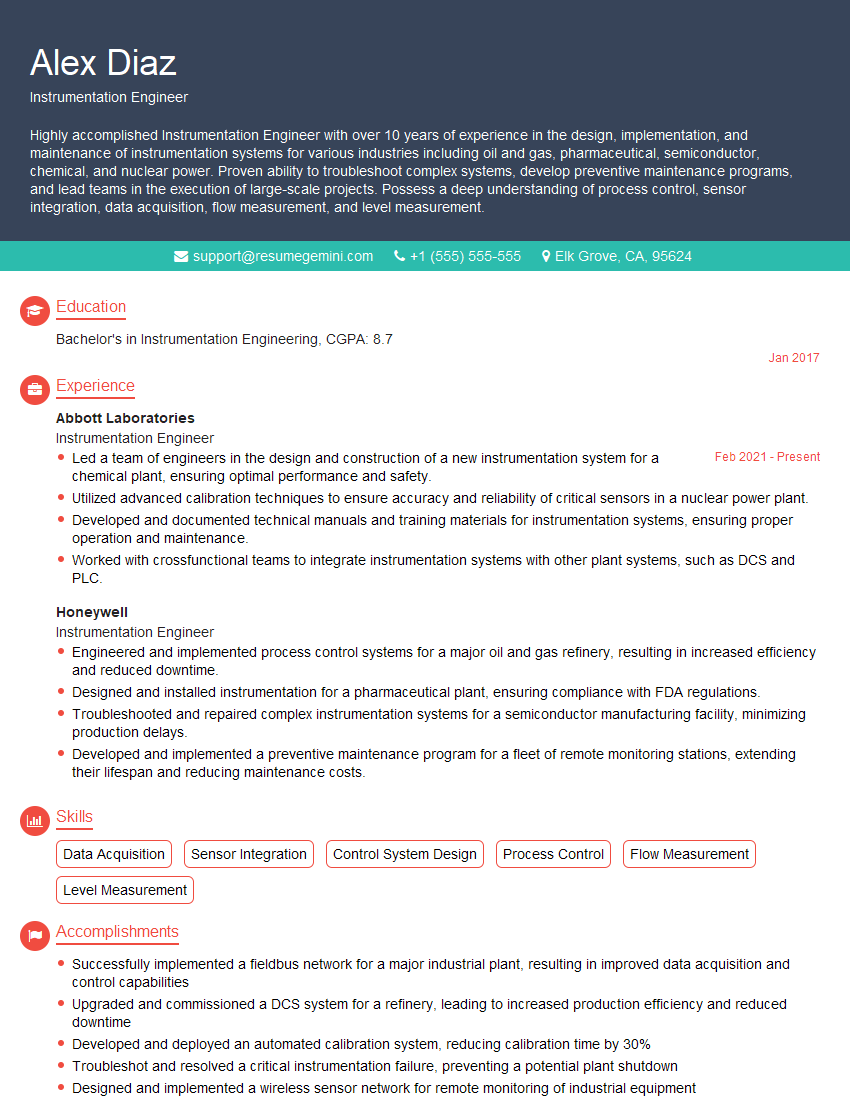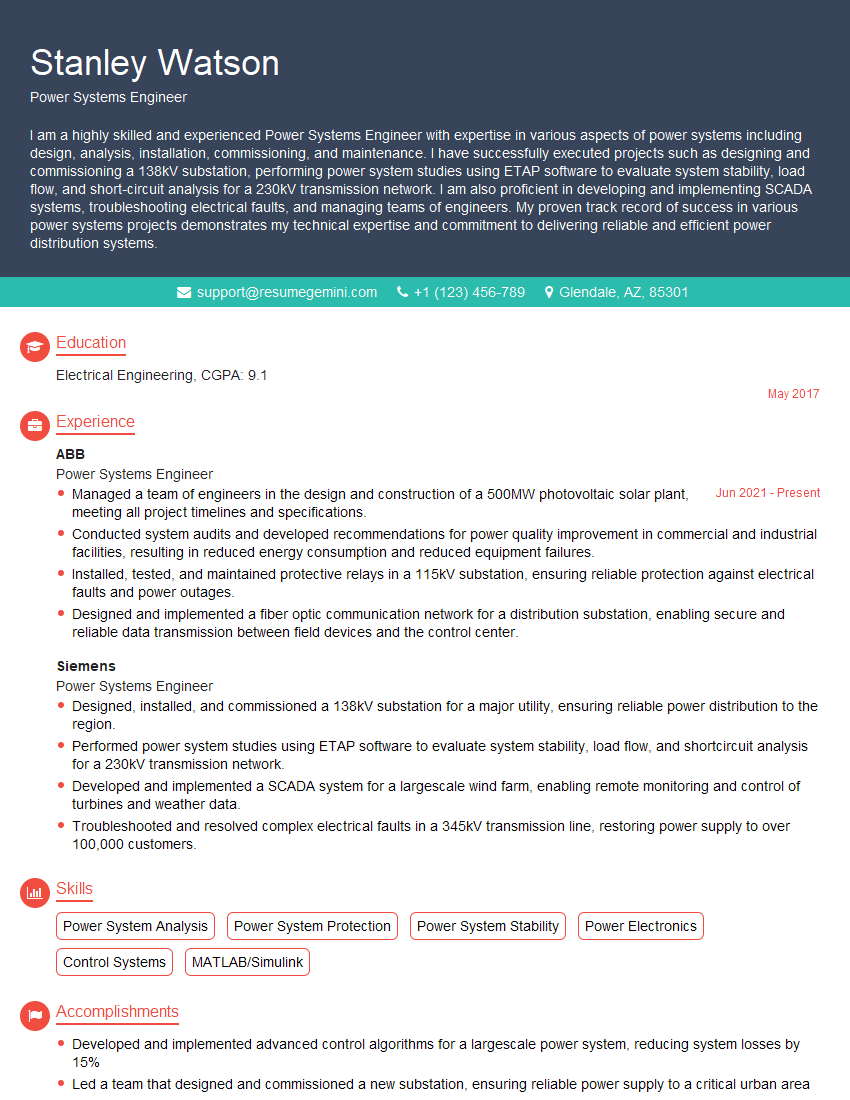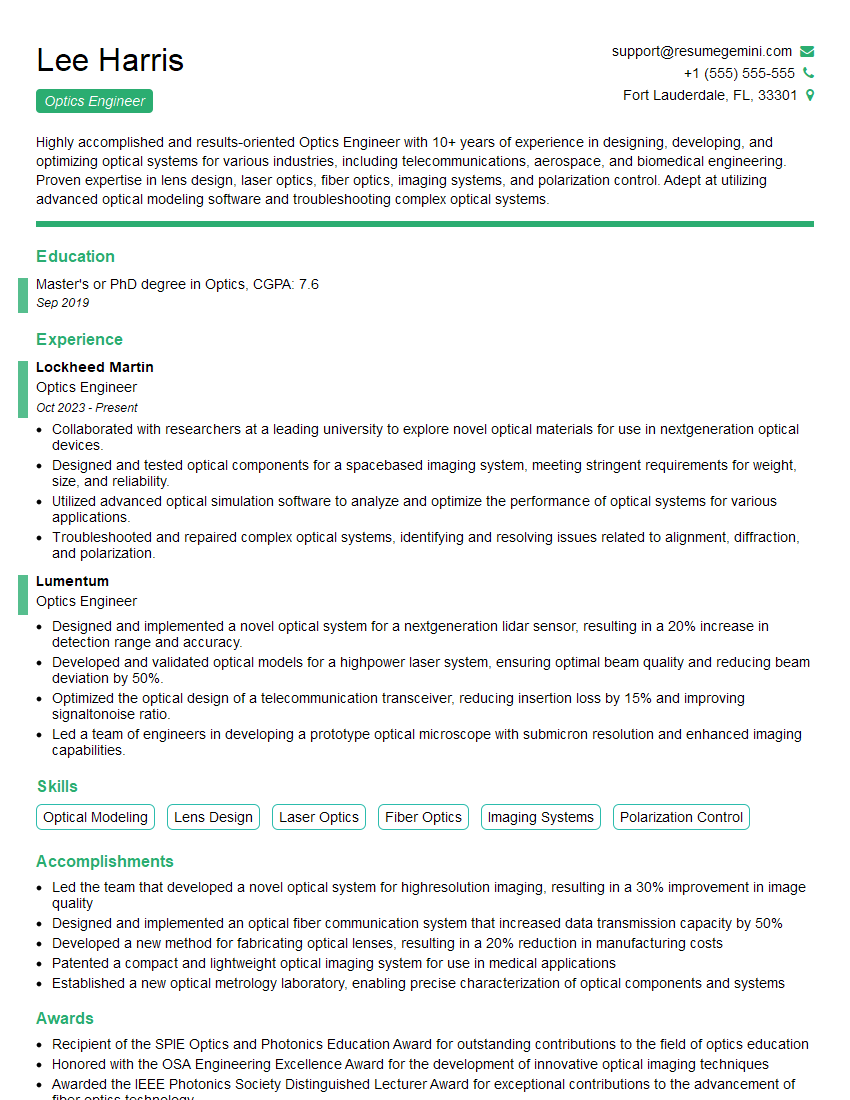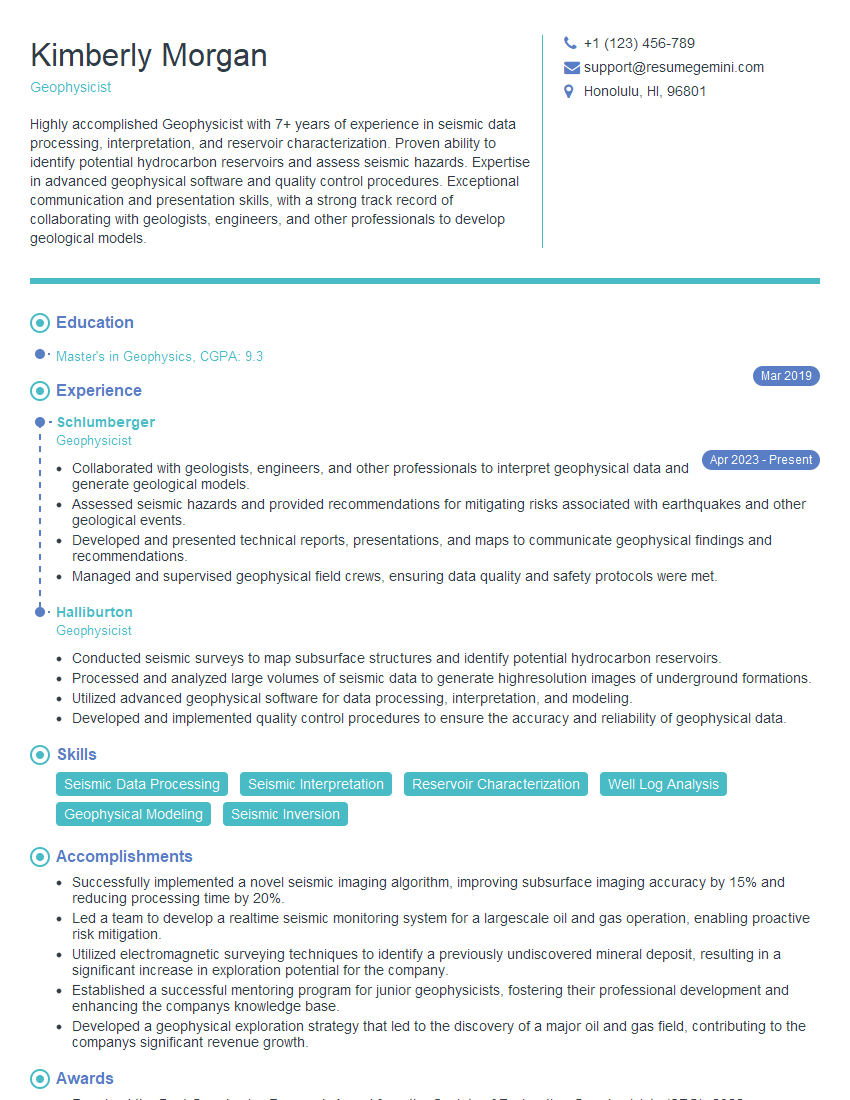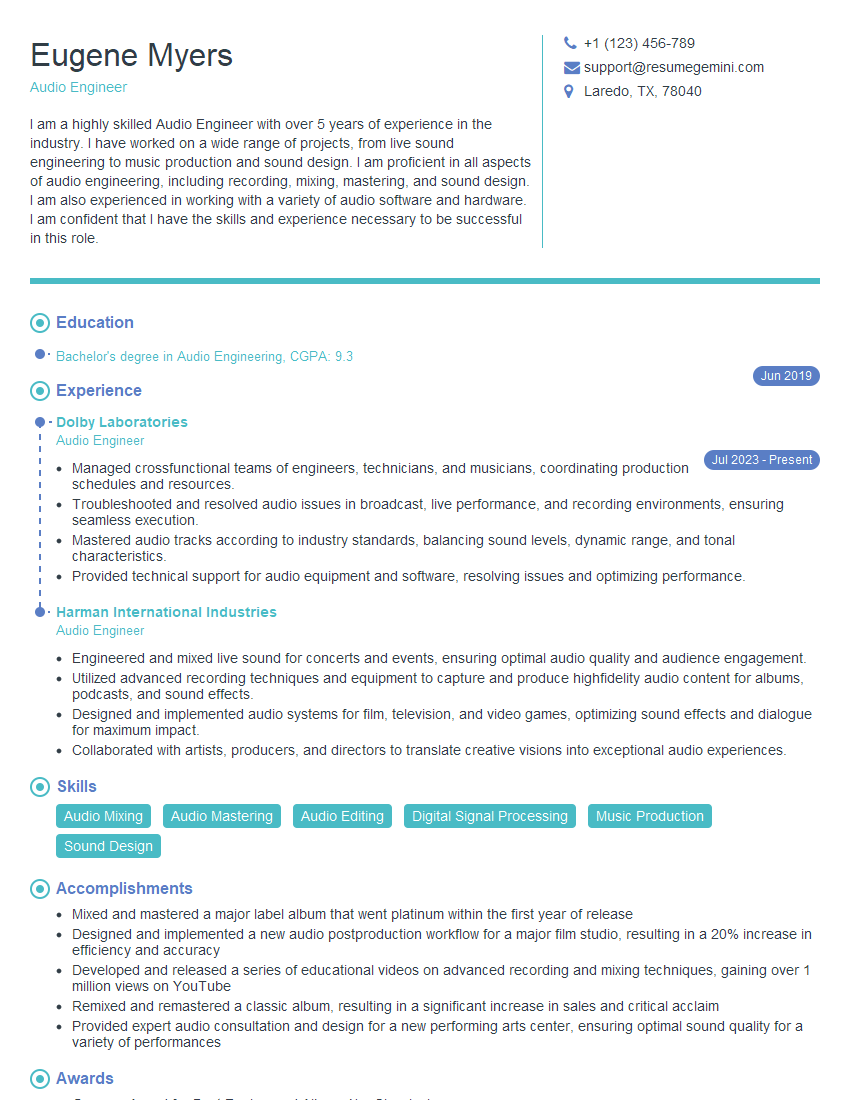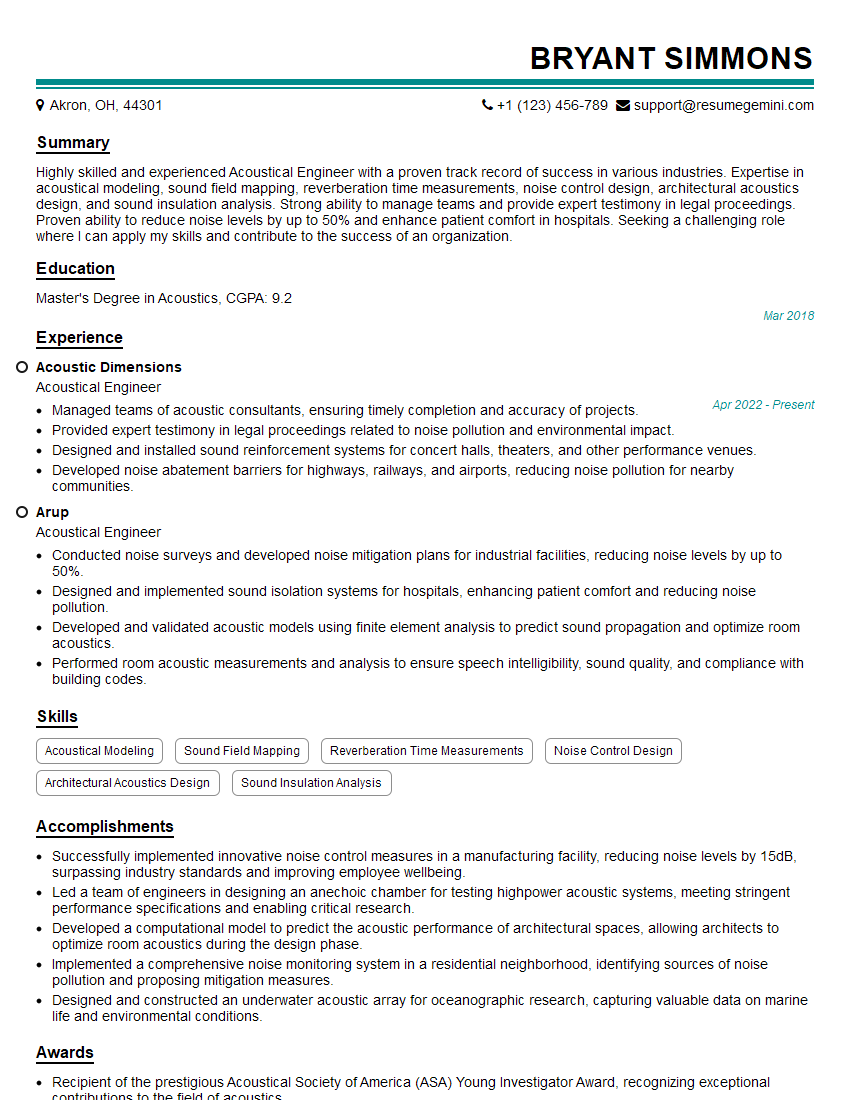Are you ready to stand out in your next interview? Understanding and preparing for Waveform Analysis interview questions is a game-changer. In this blog, we’ve compiled key questions and expert advice to help you showcase your skills with confidence and precision. Let’s get started on your journey to acing the interview.
Questions Asked in Waveform Analysis Interview
Q 1. Explain the difference between analog and digital waveforms.
The core difference between analog and digital waveforms lies in how they represent information. An analog waveform is a continuous signal whose amplitude and frequency can take on any value within a given range. Think of a vinyl record – the groove’s depth continuously varies, representing the sound wave directly. In contrast, a digital waveform is a discrete signal that’s represented by a series of numerical values. It’s like converting that vinyl record’s continuous groove into a sequence of numbers representing the sound’s amplitude at specific time intervals. This digital representation loses some information, but gains resilience to noise and ease of manipulation.
Example: Imagine measuring temperature with a mercury thermometer (analog) versus a digital thermometer. The mercury thermometer shows a continuous rise or fall of the mercury level, while the digital thermometer displays discrete temperature values.
Q 2. Describe various types of waveform analysis techniques (FFT, Wavelet, etc.).
Waveform analysis employs various techniques to extract meaningful information from signals. Some prominent methods include:
- Fast Fourier Transform (FFT): This decomposes a complex waveform into its constituent frequencies, revealing the frequency spectrum. It’s like separating the different instruments in a musical piece.
- Wavelet Transform: Unlike FFT which looks at the entire signal at once, wavelet transform analyzes the signal using different ‘wavelets’ (small waves) at varying scales. This is helpful in identifying transient features and non-stationary signals, such as abrupt changes or bursts in a signal.
- Short-Time Fourier Transform (STFT): This method is a compromise between time and frequency resolution. It analyzes the signal in short time frames, so we can see how frequencies change over time, which is important for signals that are not stationary.
- Hilbert Transform: This provides the analytic signal from a real-valued signal, which helps to find the instantaneous frequency and amplitude. It’s valuable when dealing with signals that exhibit non-linear behavior.
The choice of technique depends on the nature of the signal and the desired information. For example, FFT is excellent for stationary signals with clear frequency components, while wavelet transform shines with transient events and non-stationary signals.
Q 3. How do you identify noise in a waveform and what techniques can be used to remove it?
Identifying noise in a waveform often involves visual inspection, statistical analysis, and understanding the context of the signal. Noise usually manifests as unpredictable, random fluctuations in the waveform. We visually look for irregularities that are inconsistent with the expected signal behavior. Statistically, we may calculate the signal-to-noise ratio (SNR) to quantify noise levels.
Noise removal techniques vary depending on the noise characteristics. Some common methods include:
- Filtering: This is a common approach. Low-pass, high-pass, band-pass, and notch filters selectively attenuate frequency bands containing noise while preserving the desired signal components.
- Averaging: Repeated measurements and averaging can reduce random noise. The random fluctuations tend to cancel each other out, leaving a cleaner signal.
- Median Filtering: This is a robust method that replaces each data point with the median of its neighboring points, effectively removing impulsive noise spikes.
- Wavelet Denoising: This technique uses wavelet transform to decompose the signal into different frequency bands. Noise often resides in higher frequency bands, and can be attenuated or removed before reconstruction.
Example: In an electrocardiogram (ECG), detecting and removing noise from muscle contractions is crucial for accurate diagnosis.
Q 4. Explain the concept of Fourier Transform and its applications in waveform analysis.
The Fourier Transform is a mathematical tool that decomposes a function (like a waveform) into a set of simpler sinusoidal functions of different frequencies and amplitudes. Essentially, it reveals the frequency content of a signal. It’s like taking apart a complex sound and identifying the individual musical notes that compose it.
Applications in Waveform Analysis:
- Frequency Spectrum Analysis: Identifying dominant frequencies in a signal, crucial for vibration analysis, audio processing, and image processing.
- Signal Filtering: Designing filters that selectively remove or amplify specific frequency bands.
- Signal Compression: Eliminating redundant information by focusing on important frequency components.
- System Identification: Analyzing the response of a system to different inputs by using frequency analysis.
For instance, in vibration monitoring, FFT analysis allows engineers to detect frequencies associated with potential equipment failure, leading to predictive maintenance.
Q 5. What are the advantages and disadvantages of using FFT for waveform analysis?
Advantages of FFT:
- Computational Efficiency: The FFT algorithm provides a fast way to compute the Discrete Fourier Transform (DFT), allowing rapid analysis of large datasets.
- Frequency Information: It effectively reveals the frequency components of a signal, enabling precise spectral analysis.
- Wide Applicability: It is widely used in various signal processing applications.
Disadvantages of FFT:
- Time Resolution: FFT provides poor time resolution for non-stationary signals. It’s difficult to pinpoint when a specific frequency event occurs in the signal.
- Stationarity Assumption: The FFT assumes the signal is stationary (its statistical properties don’t change over time). Non-stationary signals require different methods like wavelet transform.
- Leakage: If the signal is not periodic over the analysis window, this can lead to spectral leakage which distorts the frequency components.
Choosing FFT should carefully consider the nature of the signal. While highly efficient, its limitations regarding time resolution and non-stationary signals must be acknowledged.
Q 6. Describe the Nyquist-Shannon sampling theorem and its significance.
The Nyquist-Shannon sampling theorem is a fundamental principle in signal processing stating that to accurately reconstruct a continuous-time signal from its discrete samples, the sampling rate must be at least twice the highest frequency component present in the signal. This is the minimum sampling rate needed to avoid information loss.
Significance:
- Accurate Signal Reconstruction: Ensures you can faithfully reproduce the original signal from the sampled data.
- Avoiding Aliasing: Prevents the distortion of frequencies caused by under-sampling. High frequencies ‘fold’ into lower frequencies, mimicking lower frequency components which are not truly present in the original signal.
- Data Compression: Provides the minimum sampling rate required to avoid information loss, which can inform data compression strategies.
Example: If you’re sampling an audio signal with a maximum frequency of 20 kHz, you need at least a 40 kHz sampling rate. Otherwise, higher frequencies will alias into lower frequencies, resulting in distorted sound.
Q 7. How do you handle aliasing in waveform analysis?
Aliasing occurs when a signal is sampled at a rate lower than the Nyquist rate, resulting in a distorted representation of the original signal. High frequencies ‘fold’ into the lower frequency range, creating spurious frequencies that were not originally present.
Handling aliasing involves preventing it in the first place:
- Anti-aliasing filter: Use a low-pass filter before sampling to attenuate frequencies above half the sampling rate. This filter removes high-frequency components that could cause aliasing.
- Increase sampling rate: Increase the sampling rate to satisfy the Nyquist criterion. This ensures that all significant frequency components are captured accurately.
If aliasing has already occurred, it’s typically irreversible. Careful pre-processing and correct sampling techniques are crucial to prevent this issue, which can be a significant source of error in waveform analysis.
Q 8. Explain the concept of convolution and its application in signal processing.
Convolution is a mathematical operation that combines two signals to produce a third signal. Imagine it like this: you’re sliding one signal (the impulse response) across another (the input signal), multiplying corresponding points at each step, and summing the results. This gives you a new signal that reflects how the input signal is modified by the impulse response.
In signal processing, convolution is crucial for understanding how a system modifies an input signal. For example, if you have an audio signal passing through a loudspeaker, the loudspeaker’s characteristics (its impulse response) will convolve with the input audio, altering its frequency content and overall sound. Another example is image blurring, where a blurring filter acts as the impulse response, convolving with the original image to create a blurry version.
Convolution is also fundamental in many digital signal processing (DSP) algorithms, including filtering, deconvolution (reversing the effect of convolution), and system identification. It’s computationally expensive in its direct form, but techniques like Fast Fourier Transform (FFT) can significantly speed up the computation.
Q 9. What is a wavelet transform and how does it differ from Fourier Transform?
A wavelet transform decomposes a signal into different frequency components, similar to the Fourier Transform, but with a key difference: it does so using wavelets instead of sine waves. Wavelets are localized functions, meaning they have a defined beginning and end, unlike sine waves which extend infinitely. This localization allows wavelet transforms to better capture transient events and changes in frequency over time.
The Fourier Transform excels at analyzing stationary signals (signals with constant frequency content), but it struggles with signals that change over time. For example, it might not identify a short burst of high-frequency noise within a primarily low-frequency signal effectively. Wavelet transforms, on the other hand, are superior at analyzing non-stationary signals, making them very useful for applications involving transient phenomena such as seismic events, medical imaging (analyzing ECG or EEG signals), and image compression.
Think of it like this: the Fourier Transform is like looking at a whole photograph at once – you see the overall composition but miss subtle details. A wavelet transform is like looking at the photograph with a magnifying glass – zooming in on different sections to reveal details that are otherwise hidden.
Q 10. Describe different types of filters used in waveform analysis (low-pass, high-pass, band-pass).
Filters in waveform analysis are used to selectively modify the frequency components of a signal. They work by attenuating (reducing the amplitude of) certain frequency bands while leaving others relatively unchanged.
- Low-pass filters: Allow low-frequency components to pass through while attenuating high-frequency components. Think of it as smoothing out the signal; a good analogy is removing high-pitched noise from an audio recording.
- High-pass filters: Allow high-frequency components to pass through while attenuating low-frequency components. This is like isolating sharp changes or edges in a signal. In an audio context, it could be used to remove a constant hum.
- Band-pass filters: Allow a specific range of frequencies (a band) to pass through while attenuating frequencies outside of that range. This is useful for isolating signals within a particular frequency range, like selecting a specific radio station.
These filters can be implemented in either the analog or digital domain. Digital filters are commonly implemented using algorithms based on the Z-transform.
Q 11. How do you design a digital filter for a specific application?
Designing a digital filter involves several steps. First, you need to specify the desired filter characteristics: the type of filter (low-pass, high-pass, band-pass, etc.), the cutoff frequency(ies), the passband ripple (how much the filter’s gain varies within the passband), and the stopband attenuation (how much the filter attenuates frequencies in the stopband).
Next, you choose a filter design method. Common methods include:
- Windowing methods: Simple but less precise. They involve taking the inverse Fourier transform of an ideal frequency response and multiplying it with a window function to reduce side lobes.
- Butterworth, Chebyshev, Elliptic filters: These are classical analog filter designs that can be transformed into digital filters using the bilinear transform or other methods. They offer different trade-offs between sharpness of cutoff, ripple, and attenuation.
- FIR (Finite Impulse Response) and IIR (Infinite Impulse Response) filter design: These are based on different mathematical structures and offer distinct properties in terms of stability, phase response, and computational complexity.
Once you’ve designed the filter, you can implement it using DSP algorithms and software or hardware. Verification is crucial, involving testing the filter’s performance with various inputs and comparing the results to the design specifications.
Q 12. Explain the concept of signal-to-noise ratio (SNR).
Signal-to-noise ratio (SNR) is a measure that compares the level of a desired signal to the level of background noise. A higher SNR indicates a stronger signal relative to the noise, implying better signal quality. It’s often expressed in decibels (dB).
Imagine you’re trying to hear someone speak in a crowded room. The person’s voice is the signal, and the chatter of the crowd is the noise. A high SNR would mean the voice is loud and clear compared to the background noise, while a low SNR would mean the voice is barely audible over the crowd.
Q 13. How do you measure SNR in a waveform?
Measuring SNR in a waveform typically involves calculating the power of the signal and the power of the noise separately, then taking their ratio. The power of a signal is often calculated as the average of the squared values of the signal samples over a specified time period. If you can isolate the noise component, you can calculate its power similarly.
SNR (dB) = 10 * log10(Signal Power / Noise Power)
In practice, separating the signal from the noise can be challenging. Various techniques can be used, depending on the nature of the signal and the noise, including averaging multiple waveform samples (to reduce random noise), using filters to isolate the signal, or applying more advanced signal processing techniques such as wavelet denoising.
Q 14. What is spectral leakage and how can it be mitigated?
Spectral leakage is a phenomenon that occurs when a non-integer number of cycles of a periodic signal are included in a finite observation window. This results in the signal’s energy being spread across multiple frequency bins in the frequency spectrum, blurring the true frequency content and creating spurious peaks.
Imagine trying to measure the height of a wave using only a short section of a much longer wave. You might get an inaccurate measurement that doesn’t represent the true height of the wave. Spectral leakage is similar: because the observed signal is truncated, the Fourier transform doesn’t perfectly capture the true frequencies of the signal.
Mitigation strategies include:
- Zero-padding: Adding zeros to the end of the signal before performing the FFT increases the number of points in the frequency spectrum, providing better resolution and reducing leakage.
- Windowing: Applying a window function (such as a Hamming or Hanning window) to the signal before the FFT tapers the signal’s amplitude towards the edges of the window, reducing discontinuities and mitigating leakage. However, windowing also introduces some smearing.
- Choosing appropriate signal length: If possible, ensuring the signal length encompasses an integer number of cycles reduces leakage.
Q 15. Explain the concept of time-frequency analysis.
Time-frequency analysis is a crucial technique in signal processing that allows us to examine how the frequency content of a signal changes over time. Unlike the Fourier Transform, which provides a frequency spectrum representing the entire signal’s frequency components but loses time information, time-frequency analysis reveals both the frequency and time characteristics simultaneously. Imagine listening to an orchestra; a standard Fourier Transform would give you a list of all the instruments playing, but wouldn’t tell you *when* each instrument played its notes. Time-frequency analysis, on the other hand, provides a detailed picture of which instruments played which notes at which times.
Career Expert Tips:
- Ace those interviews! Prepare effectively by reviewing the Top 50 Most Common Interview Questions on ResumeGemini.
- Navigate your job search with confidence! Explore a wide range of Career Tips on ResumeGemini. Learn about common challenges and recommendations to overcome them.
- Craft the perfect resume! Master the Art of Resume Writing with ResumeGemini’s guide. Showcase your unique qualifications and achievements effectively.
- Don’t miss out on holiday savings! Build your dream resume with ResumeGemini’s ATS optimized templates.
Q 16. What are the different methods for time-frequency analysis (e.g., Short-Time Fourier Transform, Wavelet Transform)?
Several methods exist for time-frequency analysis, each with strengths and weaknesses. Two prominent ones are:
- Short-Time Fourier Transform (STFT): This method works by dividing the signal into small, overlapping segments. A Fourier Transform is then applied to each segment, providing a frequency spectrum for that particular time window. The size of the window is a critical parameter; a smaller window offers better time resolution but poorer frequency resolution, and vice-versa. Think of it like using a magnifying glass – you can focus on a small area (high time resolution) but see less detail (low frequency resolution), or zoom out to see more detail (high frequency resolution) but lose focus on precise timing (low time resolution).
- Wavelet Transform: Wavelets offer an alternative approach. Instead of using a fixed-size window like the STFT, the wavelet transform employs wavelets – functions with limited duration and varying frequencies – to analyze the signal. This allows for better time resolution at high frequencies and better frequency resolution at low frequencies, adapting to the signal’s characteristics. Wavelets are particularly effective at analyzing signals with transient events or abrupt changes, providing a more nuanced time-frequency representation than the STFT.
Other methods include the Wigner-Ville distribution and the spectrogram, each having its own properties and best-suited applications.
Q 17. How do you identify periodic components in a waveform?
Identifying periodic components involves several techniques. A straightforward approach is to inspect the signal’s frequency spectrum obtained via Fourier Transform. Prominent peaks in the spectrum correspond to the dominant frequencies present in the signal. The frequencies at which these peaks occur represent the frequencies of the periodic components. For instance, a strong peak at 50 Hz in the power spectrum of a signal suggests a 50Hz periodic component.
Further analysis can be conducted using autocorrelation. The presence of distinct peaks in the autocorrelation function at regular intervals signifies periodicity, and the spacing between peaks indicates the period of the component. For example, if peaks appear every 20 milliseconds in the autocorrelation, the signal contains a 50 Hz component (1/0.02 seconds = 50 Hz).
Q 18. Explain the concept of autocorrelation and its applications.
Autocorrelation measures the similarity of a signal with a time-shifted version of itself. It reveals patterns and periodicities within the signal. The autocorrelation function is a plot of the correlation coefficient between the signal and its shifted versions as a function of the time shift. High values indicate strong similarity; low values indicate low similarity.
Applications of autocorrelation include:
- Periodicity detection: As mentioned previously, peaks in the autocorrelation function indicate periodicities. This is useful in various applications such as analyzing rhythmic patterns in music or detecting repeating signals in communication systems.
- Signal estimation: In the presence of noise, autocorrelation can help estimate the underlying periodic signal by averaging out the noise effects. This is useful in applications such as removing noise from images or audio recordings.
- Delay estimation: The location of the peak in the cross-correlation of two signals can be used to estimate the time delay between them. This has crucial applications in radar and sonar systems.
Q 19. How do you detect transient signals in a noisy waveform?
Detecting transient signals in noisy waveforms requires techniques that enhance the signal-to-noise ratio (SNR). Wavelet transforms are particularly well-suited for this task because of their ability to provide good time resolution at high frequencies, where transients often reside. By selecting appropriate wavelet functions and thresholds, we can isolate transient features from background noise.
Other approaches include applying matched filtering, which correlates the noisy signal with a known template of the expected transient, enhancing the signal at the locations that match the template. Adaptive thresholding techniques can also be employed; these adaptively adjust the threshold based on local signal statistics to improve detection sensitivity and reduce false positives.
A common strategy involves a combination of techniques: a wavelet transform might be used to initially highlight potential transient regions, followed by more refined analysis techniques like matched filtering or advanced thresholding methods within these regions to achieve accurate detection.
Q 20. Describe your experience with different waveform analysis software packages (e.g., MATLAB, Python libraries).
I possess extensive experience with MATLAB and Python libraries like SciPy and NumPy for waveform analysis. In MATLAB, I’ve leveraged its Signal Processing Toolbox extensively for tasks such as Fourier transforms, wavelet transforms, filter design, and spectral analysis. I’ve used this to analyze a wide range of signals, from seismic data for earthquake analysis to biomedical signals for diagnosing cardiac arrhythmias. Python’s flexibility has also been valuable; SciPy’s signal processing modules and Matplotlib’s visualization capabilities have been instrumental in automating tasks and creating interactive visualizations.
I am proficient in using these tools to perform advanced analysis, including developing custom algorithms and integrating them into efficient workflows. For instance, I have used MATLAB to develop an algorithm for detecting microseismic events and Python to create a user-friendly interface for analysis of EEG data.
Q 21. Explain your experience in implementing waveform analysis algorithms.
My experience in implementing waveform analysis algorithms spans various applications and methodologies. I have developed algorithms for:
- Noise reduction: Implementing adaptive filtering and wavelet denoising techniques for improving the quality of noisy signals.
- Feature extraction: Designing algorithms for extracting relevant features from waveforms, like peak frequencies, time intervals between events, and various spectral characteristics. This frequently involves using time-frequency representations and applying machine learning techniques.
- Signal classification: Creating algorithms for automatically classifying waveforms into different categories based on their unique characteristics, using both traditional signal processing techniques and advanced machine learning classifiers.
- Signal detection: Developing algorithms for identifying specific events or patterns within complex signals, using techniques like matched filtering, wavelet thresholding, and statistical change-point detection.
I am comfortable working with both theoretical algorithm design and practical implementation, ensuring efficiency and scalability. I am also adept at choosing the right algorithm for the specific problem at hand, considering factors like computational cost, accuracy, and robustness.
Q 22. How do you approach troubleshooting problems in waveform analysis?
Troubleshooting waveform analysis problems is a systematic process. I begin by thoroughly understanding the context: the source of the waveform data, the instrumentation used, and the expected characteristics of the signal. My approach involves several key steps:
- Visual Inspection: I start with a visual examination of the waveform using various display options (linear, logarithmic, etc.). This often reveals obvious anomalies like noise, clipping, or unexpected frequencies.
- Data Validation: I check the data for consistency and plausibility. This includes verifying the sampling rate, time base accuracy, and the presence of any calibration information. Discrepancies here can lead to incorrect interpretations.
- Signal Characterization: I analyze the waveform’s key features: amplitude, frequency, phase, and harmonic content. Deviation from expected values points towards potential issues.
- Filtering and Noise Reduction: Noise is a common problem. I apply appropriate filtering techniques (e.g., moving average, FFT filtering) to isolate the signal of interest and mitigate noise effects.
- Instrumentation Check: If the problem persists, I investigate the acquisition system. This may involve calibrating equipment, checking for impedance mismatches, or reviewing the system’s configuration settings.
- Comparison with Known Signals: I compare the waveform to known reference signals or templates to identify discrepancies and guide further investigation.
- Root Cause Analysis: Once the problem is isolated, I perform a thorough root cause analysis to prevent future occurrences. This might involve modifying data acquisition procedures or improving signal processing techniques.
For example, if a biomedical signal shows unexpected high-frequency oscillations, I would check for electromagnetic interference, explore the possibility of artifacts from the sensor itself, or investigate the patient’s condition.
Q 23. Describe a challenging waveform analysis project you’ve worked on and your role in it.
One challenging project involved analyzing complex vibration waveforms from a jet engine during testing. My role was to identify the sources of anomalous vibrations that could indicate potential mechanical failures. The data set was enormous, containing multiple sensor readings at high sampling rates.
The challenge lay in separating the subtle, yet critical, vibrational signatures associated with component faults from the overwhelming background noise stemming from the engine’s normal operation. To overcome this, I employed several advanced techniques:
- Order Tracking: This method analyzed vibrations based on the engine’s rotational speed, allowing me to isolate frequency components directly related to specific engine components.
- Wavelet Transform: This helped to efficiently decompose the signal into different frequency bands, revealing time-localized features that were otherwise masked by noise.
- Statistical Analysis: I used statistical methods to identify patterns and anomalies in the data that indicated potential faults. This involved using techniques like threshold detection and outlier analysis.
Through careful analysis and the combination of different signal processing methods, we successfully identified a subtle bearing fault that would have likely led to catastrophic engine failure if undetected. This highlighted the critical importance of robust and thorough waveform analysis in predictive maintenance.
Q 24. What are some common errors or pitfalls in waveform analysis?
Common errors and pitfalls in waveform analysis stem from both data acquisition and analysis phases:
- Aliasing: Sampling a signal at a rate lower than twice its highest frequency leads to inaccurate representation of the signal (Nyquist-Shannon sampling theorem). This results in the lower frequency component being misinterpreted as higher frequency.
- Noise: Environmental noise, sensor noise, and quantization noise can corrupt the signal, making accurate interpretation challenging. Poor signal-to-noise ratio (SNR) directly impacts the analysis’s reliability.
- Incorrect Triggering: Improperly triggered data acquisition can lead to incomplete or misaligned waveforms, making accurate analysis impossible.
- Misinterpretation of Artifacts: Spurious signals or artifacts can be easily mistaken for genuine signal features, leading to inaccurate conclusions.
- Overfitting in Signal Processing: Using overly complex signal processing techniques can lead to overfitting, where the model fits the noise instead of the underlying signal. This results in poor generalization.
- Ignoring the physical context: Analyzing a waveform without understanding the underlying system can lead to erroneous interpretations. Context is crucial for informed analysis.
For example, misinterpreting a powerline interference in a biomedical signal as a physiological phenomenon could lead to a misdiagnosis.
Q 25. How do you ensure the accuracy and reliability of your waveform analysis results?
Ensuring accuracy and reliability requires a multifaceted approach:
- Calibration and Verification: Regular calibration of instrumentation and cross-verification of measurements are essential. Using multiple sensors or measurement techniques enhances confidence.
- Appropriate Signal Conditioning: Using proper signal conditioning techniques (amplification, filtering, impedance matching) improves the signal-to-noise ratio and enhances accuracy.
- Robust Signal Processing Methods: Choosing appropriate signal processing techniques based on the characteristics of the waveform and the goals of the analysis. Using multiple analysis techniques and comparing the results increases confidence.
- Error Propagation Analysis: Quantifying uncertainty in measurements and propagating errors throughout the analysis chain is crucial to understanding the reliability of the results.
- Documentation and Traceability: Detailed documentation of the entire analysis process, including data acquisition methods, processing steps, and assumptions made, is essential for reproducibility and verification.
For instance, in analyzing the structural health of a bridge, careful consideration of environmental factors, sensor placement, and error analysis are crucial to ensuring the reliability of assessments about the bridge’s integrity.
Q 26. How would you explain complex waveform analysis concepts to a non-technical audience?
Explaining waveform analysis to a non-technical audience requires simplifying complex concepts using analogies.
I would explain that a waveform is simply a visual representation of how a signal changes over time, much like a graph showing stock prices. The peaks and valleys represent changes in the signal’s strength or value. We analyze these patterns to extract meaningful information.
I would then use examples like sound waves (representing music or speech) or heartbeats (representing the rhythm of the heart). The shape and frequency of these waves provide valuable information; for instance, a rapid or irregular heartbeat could indicate a health problem. Similarly, analyzing the vibrations of a machine can help predict potential failures before they occur.
Instead of focusing on technical terms, I would emphasize the practical applications and real-world impacts of waveform analysis, demonstrating how it helps us understand and improve various systems, from medical devices to aircraft engines.
Q 27. What are your preferred methods for visualizing waveform data?
My preferred methods for visualizing waveform data depend heavily on the specific application and the nature of the signal.
- Time-domain plots: Simple, yet powerful, for showing the signal’s amplitude over time. This is often the first step in analyzing any waveform.
- Frequency-domain plots (using FFT): Essential for understanding the frequency components of the signal. Useful for identifying periodic components, noise, and harmonics.
- Spectrograms: Ideal for analyzing signals whose frequency content changes over time. They display frequency content as a function of time, creating a visual ‘fingerprint’ of the signal.
- Wavelet transforms: Offer excellent time-frequency resolution, useful for analyzing signals with both transient and stationary components.
- 3D plots: Useful for visualizing signals with multiple dimensions, such as those from multiple sensors or channels.
I utilize software packages like MATLAB, Python (with libraries such as SciPy and Matplotlib), and specialized waveform analysis tools to create these visualizations. The choice of visualization method significantly affects the ease and effectiveness of interpretation.
Q 28. How do you stay current with advancements in waveform analysis techniques?
Staying current with advancements in waveform analysis is a continuous process. My strategies include:
- Reading scientific literature: I regularly read journals and publications in signal processing, digital signal processing, and related fields.
- Attending conferences and workshops: These provide opportunities to learn about the latest research and interact with leading experts.
- Participating in online communities: Engaging in online forums and communities focused on signal processing allows for interaction with other professionals and exposure to new ideas.
- Taking online courses: Platforms such as Coursera and edX offer courses on advanced signal processing techniques and waveform analysis methods.
- Following key researchers and institutions: I actively follow influential figures and institutions in the field to stay abreast of emerging trends and breakthroughs.
Continuous learning in this rapidly evolving field is paramount to providing accurate and state-of-the-art waveform analysis. New techniques and algorithms are constantly emerging, so remaining updated is crucial for maintaining expertise.
Key Topics to Learn for Waveform Analysis Interview
- Fundamental Waveform Characteristics: Amplitude, frequency, phase, period, and their interrelationships. Understanding how these parameters influence signal behavior is crucial.
- Types of Waveforms: Become familiar with common waveform types like sinusoidal, square, triangular, sawtooth, and their applications in various fields (e.g., electronics, acoustics, biomedical engineering).
- Waveform Generation and Measurement: Understand the principles behind waveform generation using different instruments (oscilloscope, function generator) and techniques for accurate measurement and analysis.
- Signal Processing Techniques: Explore basic signal processing concepts like filtering (low-pass, high-pass, band-pass), amplification, and attenuation, and their impact on waveform analysis.
- Fourier Analysis and its Applications: Grasp the fundamental concepts of Fourier Transforms and their role in decomposing complex waveforms into simpler components. Understand how this aids in frequency domain analysis.
- Time-Frequency Analysis: Explore techniques like Short-Time Fourier Transform (STFT) and Wavelet Transform for analyzing non-stationary signals where frequency content changes over time.
- Practical Problem-Solving: Practice analyzing real-world waveforms. Consider scenarios involving noise reduction, signal identification, and fault detection to develop robust problem-solving skills.
- Specific Applications (Tailor to your field): Deepen your understanding of waveform analysis within the context of your target role. This might involve specific applications in telecommunications, audio processing, or medical imaging.
Next Steps
Mastering waveform analysis significantly enhances your prospects in a wide range of technical fields, opening doors to exciting career opportunities. A strong understanding of these concepts demonstrates valuable analytical and problem-solving abilities highly sought after by employers.
To maximize your chances of landing your dream job, it’s essential to present your skills effectively. Crafting an ATS-friendly resume is key to ensuring your application gets noticed. ResumeGemini is a trusted resource to help you build a professional and impactful resume that highlights your waveform analysis expertise.
We provide examples of resumes tailored to Waveform Analysis to help guide you. Use these examples as inspiration to create a compelling narrative that showcases your skills and experience.
Explore more articles
Users Rating of Our Blogs
Share Your Experience
We value your feedback! Please rate our content and share your thoughts (optional).
What Readers Say About Our Blog
Hi, I represent an SEO company that specialises in getting you AI citations and higher rankings on Google. I’d like to offer you a 100% free SEO audit for your website. Would you be interested?
good

